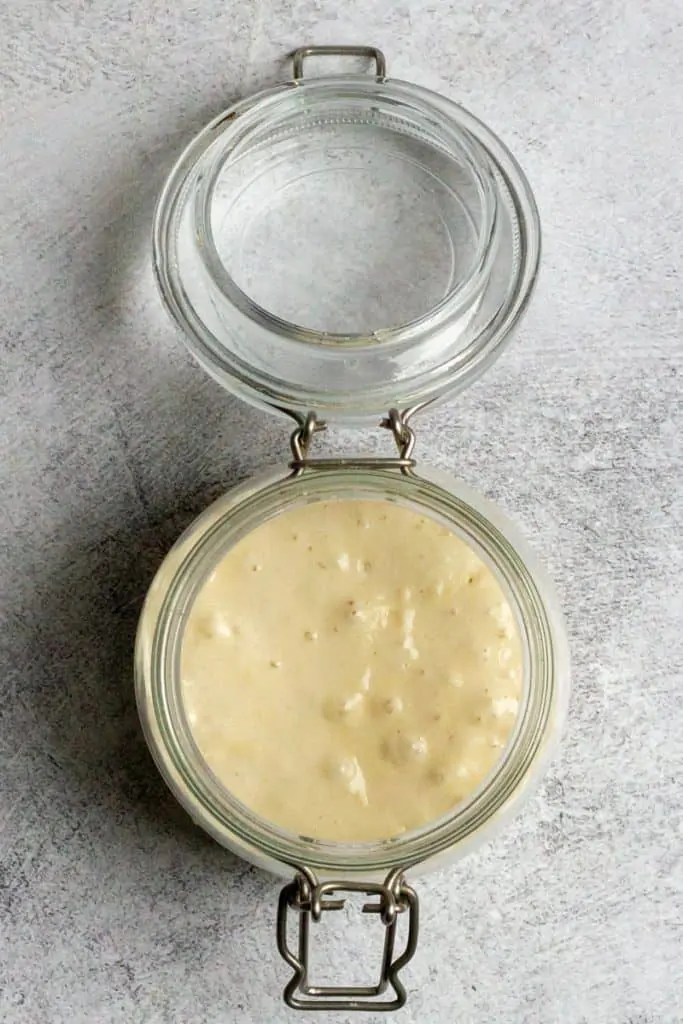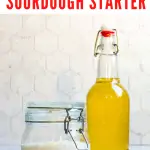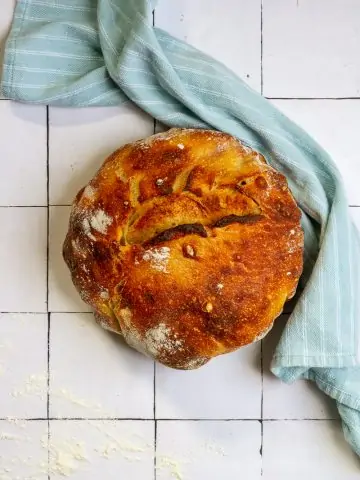Want to get started with sourdough? Try this extra quick and easy kombucha sourdough starter that’s ready in about one or two days!

Who else is excited about sourdough?
Although, it might be fair to say that I'm even more excited about sourdough discard than active sourdough.
I've been making lots of sourdough discard pancakes!
We've had sourdough oatmeal pancakes, sourdough pumpkin pancakes, sourdough blueberry pancakes and gluten-free sourdough pancakes. Like I said, so many pancakes!
But before you can do anything with sourdough, you need a sourdough starter.
If you're just using flour and water, sourdough can take weeks to ferment. Yes, that's right, weeks.
However, if you've already got a little fermentation station going in your kitchen, you've got an advantage.
Fermented drinks can be used instead of water to jump-start your sourdough starter, giving you a ready-to-use starter in as little as a day or two. It's pretty fabulous.
I love using this technique for a milk kefir sourdough starter, and it works just as well with kombucha.
This easy kombucha sourdough starter is ready to use within about 24 to 48 hours and produces a gorgeous, bubbly starter.
Want to try other ferments? Try making homemade sauerkraut, red cabbage sauerkraut, fermented garlic, fruit vinegar and water kefir.
What Is Kombucha?
Kombucha is a lightly fermented tea. I like to make homemade kombucha, hard kombucha and even kombucha popsicles.
This kombucha sourdough starter will likely work best with homemade kombucha. If you're buying kombucha, make sure it contains live cultures and has not been pasteurized.
For this recipe, you'll need plain, unflavored kombucha.
Should I Add a SCOBY?
No. Leave your kombucha SCOBY where it belongs, in kombucha.
All you need for this sourdough starter is the liquid.
What Is Sourdough?
Sourdough is a method of naturally leavening flour. Similar to other wild ferments, it uses wild yeast and lactic acid in the environment to encourage microbial growth.
Much like a kombucha SCOBY or a vinegar mother, the sourdough starter helps encourage healthy bacterial growth, and keeps your fermenting flour safe.
Will a Kombucha Sourdough Starter Taste Different Than One Made with Water?
Possibly, but only at first.
As you keep feeding your starter, the it will use yeast and lactic acid from its current environment, which affects the flavor.
The environment matters more than the starter liquid.
Will This Work with Gluten-Free Flour?
Yes! I've made this starter successfully with rice flour.
Check the recipe card notes for gluten-free flour tips.
No-Maintenance Sourdough Starter
Because this starter is so quick to make, don't feel obligated to obsessively care for it.
If you like, you can make the starter, maybe even feed it for a day or two, and then use it all up in a recipe.
Then, start over when you're ready to use sourdough again.
This is an especially nice option if you're not a frequent baker or if you're using a harder-to-maintain gluten-free sourdough starter.
How to Make a Kombucha Sourdough Starter
If you're already familiar with a traditional flour and water starter technique, this one is similar. You're just using kombucha instead of water.

Mix together 2 ounces of kombucha and 2 ounces of flour.
It's best to measure the flour by weight with a digital kitchen scale, but I've also had some success with an inexpensive analog kitchen scale.

The mixture should be the consistency of pancake batter.
If it seems thinner, add a little more flour. If it's extra thick (or won't absorb all the flour), add a little more kombucha.
Add the kombucha and flour mixture to a glass jar.

Stir the mixture at least once a day.
Within a day or two, you should see the starter become bubbly and active.
When the mixture has doubled in size, it's ready to use.

Will This Starter Be Ready For Bread in One Day?
Unfortunately, it probably won't be. But you'll get there a lot faster than if you started with just water and flour.
That said, your starter should be ready to use in sourdough discard recipes within a day or two, as soon as it's bubbly, active and growing.
To check your starter for bread, pinch off a small piece of active starter and place it in water. If it floats, it's ready.
If it doesn't, move onto the maintenance stage and keep feeding it until it's very active.

I like to monitor my starter's growth by placing a rubber band on the jar (at the starter's height) right after feeding.
As the starter grows, you can watch it pass the rubber band line.
Once your starter is very active, try making Dutch oven sourdough bread, rosemary garlic sourdough bread and sourdough cinnamon bread.
Can I Maintain This Starter with Water?
Yes, absolutely!
Once the starter is bubbly, there's no need to use more kombucha, because the cultures are already live and active.
Simply maintain this starter with water and flour, and save the kombucha for drinking!
That said, if your starter ever becomes sluggish or doesn't seem to be as healthy as it used to be, try reviving it by feeding it with kombucha and flour (instead of water and flour).
Kombucha Sourdough Starter
Equipment
- 1 glass jar
Ingredients
Initial Starter Materials:
- 2 ounces flour (~½ cup, measure by weight if possible) See "Flour Tips" Recipe Notes
- 2 ounces kombucha (plain with live cultures) See "Kombucha Tips" Recipe Notes
Starter Maintenance (Optional):
- 2 ounces flour (~½ cup, measure by weight if possible) Use same flour as original starter, or slowly transition to another type of flour
- 2 ounces non-chlorinated water (¼ cup)
Instructions
Initial Starter:
- In a clean glass jar, whisk together the flour and kombucha. (I like to use a fork to whisk.) The mixture should be the consistency of pancake batter. If yours is much thicker, add a little more kombucha to thin it out, or if it seems very thin add more flour. (I've found rice flour needs slightly more kombucha.)Cover the jar. (Cover can be loose or air-tight, see "container tips" recipe notes.)Store jar in at room temperature (about 70°-75° F).

- Stir the flour and kombucha once or twice a day, until the starter is bubbly and has doubled in size. Your starter should be ready to use within about 24 to 48 hours. You should have approximately 1 cup of starter.

- No Maintenance Starter: You can proceed to use the entire batch in a recipe, skipping any starter maintenance, and simply remake the starter as desired. This is a nice option if you don't want to maintain a starter, or if you're using a gluten-free flour that may be difficult to maintain."Float Test" for Bread: Once the starter has doubled in size and is bubbly, it should have a nice enough flavor to use the discard right away in discard recipes. To test if the starter is ready for bread, pinch of a small piece of the starter and drop it in water. If it floats, it can be used in bread. If it doesn't, proceed to the starter maintenance stage and keep feeding the starter until it passes the float test.

Starter Maintenance:
- Discard the starter down to 2 ounces (~½ cup). You can use the discard in a "discard" recipe.Whisk together 2 ounces of flour, 2 ounces of water and 2 ounces of starter. Note that from this point on, you can feed the starter with water instead of kombucha.Cover the jar, whisking once or twice a day. When the starter is bubbling and doubled in size, repeat the process. Continue discarding and feeding once a day, or place into storage until ready to use again.To store the starter: Feed the starter and then move it immediately into the fridge. Remove from the fridge and allow the starter to warm up for a few hours before using. Depending on how long the starter was in the fridge, it may take a few days to become very active again. Ideally, feed starter at least once a week even when in storage.

Notes
- Unbleached all-purpose flour is perfect for your starter. It's less finicky than some other flours.
- Gluten-free flours (such as rice flour, sorghum flour, millet flour and arrowroot flour) will work to varying degrees, but may be much more difficult to maintain. Avoid using gluten-free flours with xanthan gum (a thickening additive). Avoid using nut flours (such as almond flour), as these likely will not work.
- If possible, use organic flour. It will be easier for the good bacteria to grow with organic flour.
- Use plain, unflavored kombucha with live probiotics.
- This technique will likely work best with homemade kombucha. It will not work with pasteurized kombucha, so read the label on store-bought kombucha carefully.
- Do not add kombucha SCOBY to the flour, only the liquid tea.
- Use non-chlorinated water. (Chlorine will discourage, or even finish off, the good bacteria you're trying to grow.)
- Non-filtered tap water is generally chlorinated. I use a reverse osmosis filter for my water, but filtered water should work just fine.
- If your kitchen is cold, your sourdough starter may struggle to get started. Try placing your starter somewhere warm (like on top of your fridge).
- For a cold kitchen, try using warm (not hot) water for your starter maintenance. Hot water can ruin your starter.
- My preference is to loosely cover the jar. You can use a paper towel and a rubber band, or a jar with a non-air-tight lid. I use a swing-top jar with the rubber seal removed.
- If you use a loosely fitting lid, you may find that your sourdough starter will sometimes develop a thin skin on top. This is simply dried-out dough. You can peel it off or stir it back in, but it won't harm your dough (or your baked goods).
- If you choose to ferment or store your sourdough in an air-tight container, make sure that there is plenty of room for the dough to expand. If the jar is too small, the sourdough could burst out of the jar (or even bust the jar itself), creating quite a mess.
- Keep it clean. Make sure to always use clean utensils and jars when working with sourdough. Contaminating the dough can cause problems.
- Liquid on top of the starter. If you see liquid on top of your starter, it's called hooch. Drain it off and feed your starter immediately. I've typically only had problems with hooch when I was adding too much liquid to the starter.
- Measure the flour by weight if possible. Ideally, use a digital scale, but I've had success with even a cheap analog scale. One cup of all-purpose flour does not weigh the same as one cup of whole wheat flour, so it can be harder to know how much liquid to add without using a scale. If using unequal amounts of flour and water, you could have problems with hooch (see above), or simply less consistent results.







Cheryl S
Hello there! Looking forward to trying this recipe. Do I use the vinegar from my kombucha hotel or from my batch of bottled kombucha?
Thank you!
Alisha Trenalone
Hi Cheryl! You can use either bottled or from your scoby hotel as long as it's plain and not flavored! That's the main thing. Let us know how it goes!
-Alisha at Champagne Tastes
CANDY J HILL
This recipe is perfect! I've always wondered if I could use my over proofed kombucha for anything and now I can! Not only did it do a wonderful job making a quick sourdough starter, but the sourdough itself was superb. My husband is a San Francisco native and he said it's as good as San Francisco sourdough. It came out light and springy with just the perfect flavor. I also think you have something in the weighing of the ingredients, when I'm being lazy I cup measure but weighing when baking yields such a wonderful product. Thank you so much for sharing this.
Alisha Trenalone
You're so welcome! We're thrilled that it turned out so well for you, and thanks for letting us know!
-Alisha at Champagne Tastes
Celeste
I tried this. It's been almost 48 hours and the kombucha/flour mix has not expanded at all. Any tips?
Alisha Trenalone
Hi Celeste! The author of this recipe (Sarah) isn't able to respond to questions for a few days, but I'll see if I can help you troubleshoot in the meantime! Just a quick run-down of the basics: did you use all-purpose flour, plain kombucha, and non-chlorinated water? And are you keeping your starter in a warm enough environment?
-Alisha at Champagne Tastes
Betty Chua
Hi Alisha, I used bread flour, 1/2 cup to 1/2 cup Kombucha with a lot of yeast strands since 1/28/23. Stirred and mixed well in a glass jar, covered with cotton table napkin and used rubber band to anchor.
On 1/29/23, I mixed it and removed 1/2 cup as the discard starter, since then I add 1/2 cup bread flour and 1/2 cup plain kombucha but it has not become bubbly.
Do I have to discard 1/2 cup of the starter from the jar and feed with new flour and kombucha everyday?
It’s been over 7 days now.
Please advice. Thank you.
Alisha Trenalone
Hi Betty! This could be a few things:
1- So, the flour is measured by weight (2 ounces is 1/2 dry cup). But the kombucha is a liquid ounce measurement, and 2 ounces is only about 1/4 liquid cup. So, based on that, your measurements could be off, and that's a strong possibility for what the problem is.
2- Also, we've never tried this with bread flour, but if it's bleached, that could also be a reason it didn't work.
3- Also, even if the kombucha has yeast strands, if it's been in storage for a long time, it might not be very active. Or if it's store-bought, it might not have live cultures.
I probably would troubleshoot the above items rather than continuing to feed and discard what you have. The bubbling should have started pretty quickly if everything was good!
Hope this helps!
-Alisha at Champagne Tastes